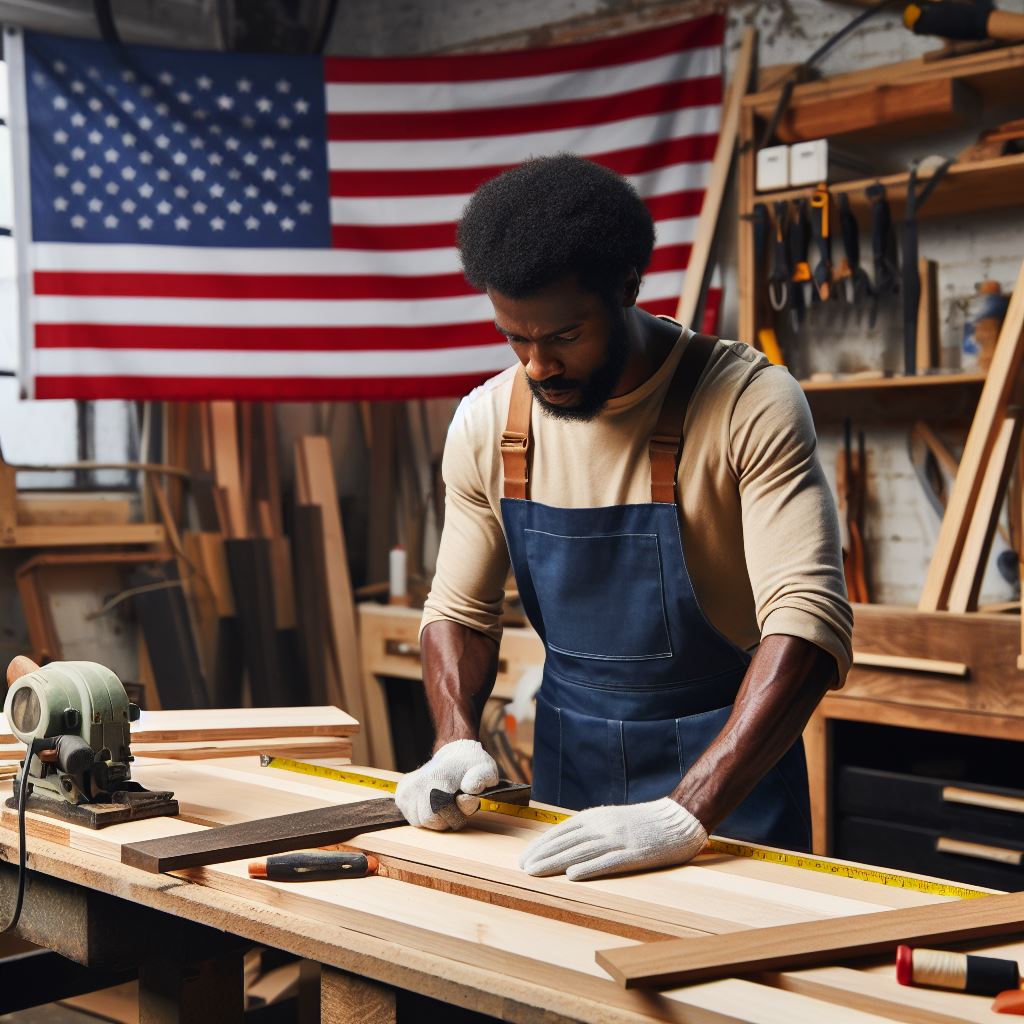Introduction
The field of carpentry has a long history, dating back centuries. Throughout the years, the craft has evolved, incorporating new tools and techniques.
Today, emerging technologies are bringing automation to the forefront of the carpentry industry.
Automation in carpentry involves the use of advanced machinery and computer-controlled systems to perform tasks that were traditionally done by hand.
This automation has revolutionized the industry, allowing for increased precision, efficiency, and productivity.
One significant impact of automation in carpentry is the ability to create complex designs and intricate patterns with greater ease.
Computer numerical control (CNC) machines can carve out precise shapes and details, reducing manual labor and time-consuming processes.
Furthermore, automation has increased safety in carpentry by reducing the risk of accidents and injuries.
Robotic systems can handle heavy materials and perform repetitive tasks, minimizing physical strain on carpenters and improving overall workplace safety.
Additionally, automation in carpentry has allowed for greater customization and experimentation.
With computer-aided design (CAD) software and automated cutting machines, carpenters can easily adapt designs, making it easier to meet unique customer requirements and bring innovative ideas to life.
In fact, automation is a game-changer in the carpentry industry. It has transformed traditional practices, enabling carpenters to work more efficiently, produce intricate designs, improve safety, and explore creative possibilities.
As technology continues to advance, the role of automation in carpentry will only continue to grow and shape the future of the industry.
The impact of automation on carpentry jobs
Decrease in manual labor and physical strain
Automation in carpentry has significantly reduced the need for manual labor and physical exertion.
Carpenters can now rely on automated tools and machinery to perform tasks that were once done manually.
By using automation, carpenters can reduce the strain on their bodies, preventing long-term health issues.
Enhanced precision and efficiency
Automation in carpentry brings a higher level of precision and accuracy to the production process.
Computer-controlled equipment ensures that each cut, measurement, and joint is executed flawlessly.
This level of precision leads to a higher quality of finished products and customer satisfaction.
Automation has also increased the speed and efficiency of carpentry tasks, reducing production time.
Reduction in time and cost of production
Automated carpentry processes can complete tasks in a fraction of the time required for manual labor.
Transform Your Career Today
Unlock a personalized career strategy that drives real results. Get tailored advice and a roadmap designed just for you.
Start NowBy reducing production time, automation helps carpenters meet deadlines and take on more projects.
Moreover, automation often leads to cost savings as fewer workers are needed for the same output.
Carpentry businesses can benefit from improved profitability due to reduced labor and increased productivity.
Shift in required job skills and training
The adoption of automation in carpentry necessitates a shift in job skills and training.
Carpenters now need to acquire knowledge in operating and maintaining automated machinery.
Training programs and certifications in automation are becoming crucial for carpenters to stay relevant.
Additionally, computer literacy and programming skills are becoming increasingly important in automated carpentry.
As automation continues to revolutionize the carpentry industry, it is essential for carpenters to embrace these changes.
Although there might be concerns about job displacement, the benefits of automation outweigh the challenges.
Carpenters can enjoy a reduced physical strain, enhanced precision, and increased efficiency in their work.
The reduced time and cost of production coupled with the need for new skills opens up opportunities for growth.
By adapting to automation and continuously improving their skills, carpenters can secure their future in the industry.
Overall, automation has transformed carpentry, leading to more efficient and precise production processes.
While this shift requires carpenters to learn new skills, it also presents opportunities for career advancement.
Embracing automation allows carpentry businesses to thrive and adapt to the evolving needs of the market.
By understanding and leveraging automation’s impact, carpenters can stay ahead in an increasingly competitive industry.
With its numerous benefits, automation has become an integral part of the modern carpentry landscape in the United States.
Read: Union vs. Non-Union Carpentry: Pros, Cons & Differences
Advantages of Automation in Carpentry
In the world of carpentry, automation has brought numerous advantages. Let us explore the benefits it offers:
Showcase Your Business Today
Reach thousands of readers actively exploring professional services. Publish your business profile and grow your audience now.
Publish NowConsistency in Product Quality
- Automation ensures that each product manufactured is of consistent and high quality.
- By removing human error, precision is enhanced, leading to reliable and standardized results.
- Customers can trust that the carpentry products they receive meet the same quality standards every time.
Increased Production Capacity
- With automation, carpentry businesses can significantly increase their production capabilities.
- Machines can work tirelessly and efficiently, allowing for faster completion of projects.
- Higher production rates mean more products can be delivered to meet growing demands.
Elimination of Repetitive Tasks
- Many repetitive tasks in carpentry can be automated, reducing the physical strain on workers.
- Employees can focus on more complex and creative aspects of carpentry, increasing job satisfaction.
- Automation frees up time and energy, enabling workers to engage in higher-value activities.
Improved Safety Measures for Workers
- Automation introduces a safer working environment for carpentry professionals.
- Machines can handle dangerous and risky tasks, reducing the exposure of workers to potential hazards.
- Accidents and injuries caused by manual errors can be minimized, enhancing worker well-being.
In short, automation brings significant advantages to the carpentry industry.
Consistency in product quality ensures customer satisfaction and trust.
Increased production capacity helps meet growing demands and enhances business growth.
Elimination of repetitive tasks allows workers to focus on more complex and fulfilling aspects of their jobs.
Improved safety measures protect the well-being of carpentry professionals, reducing accidents and injuries.
Embracing automation in carpentry can revolutionize the industry and drive its progress forward.
Read: Financial Overview: Carpenter’s Average Salary in the US

Challenges posed by automation in the carpentry field
Automation in the carpentry field brings about various challenges that need to be addressed. These challenges include:
Job displacement and unemployment concerns
One of the main concerns with automation in carpentry is the potential for job displacement.
As technology advances and automation takes over certain tasks, there is a fear that many carpenters will no longer be needed.
This displacement could lead to higher unemployment rates within the carpentry industry, as well as a decline in job opportunities for those who have dedicated their careers to carpentry.
While automation may streamline certain processes and increase efficiency, it is essential to find a balance that preserves jobs while utilizing automation to enhance productivity.
Need for upskilling and retraining the workforce
With the onset of automation, carpenters will need to upskill and retrain to remain relevant in the changing industry.
Automation will likely require a shift in the skill sets required for carpentry work. Carpenters will need to familiarize themselves with new technologies, such as computer-aided design (CAD) software and robotic systems.
Employers and educational institutions will need to collaborate to provide training programs that equip carpenters with the necessary skills to thrive in an automated carpentry field.
By investing in upskilling, carpenters can maintain their employability and adapt to the changing industry landscape.
Potential resistance and skepticism from traditional carpenters
While automation presents numerous benefits in terms of efficiency and productivity in the carpentry field, it may face resistance from traditional carpenters.
Many traditional carpenters have honed their craft over years of experience and may view automation as a threat to their craftsmanship and job security.
Overcoming this resistance requires proper education and awareness about the advantages of automation.
Demonstrating how automation can streamline repetitive and mundane tasks can help traditional carpenters embrace and incorporate technology into their work processes.
By addressing the concerns and skepticism of traditional carpenters, the industry can ensure a smooth transition to a more automated future.
In general, while automation brings about various benefits in the carpentry field, it also poses challenges that need to be overcome.
Job displacement and unemployment concerns, the need for upskilling and retraining the workforce, and potential resistance from traditional carpenters are issues that must be addressed to ensure a successful integration of automation in the carpentry industry.
By recognizing and proactively addressing these challenges, the industry can embrace automation while preserving jobs and maintaining the craftsmanship and quality that define carpentry.
Read: Safety Protocols: Best Practices in American Carpentry
Learn More: Navigating Challenges: The Modern Carpenter’s Toolkit
Automation and the future of carpentry
Integration of robotics and artificial intelligence
Automation is revolutionizing the carpentry industry with the integration of robotics and artificial intelligence.
Carpenters are now able to utilize advanced technology to improve efficiency and accuracy in their work.
Robotic arms can handle heavy materials and perform repetitive tasks with precision.
These robotics systems are capable of cutting, shaping, and assembling wood components, reducing manual labor.
Artificial intelligence algorithms are also being employed to optimize project planning and material management.
Emergence of smart tools and machinery
The emergence of smart tools and machinery is reshaping the way carpentry tasks are performed.
Smart saws, drills, and routers equipped with sensors and connectivity features are becoming commonplace.
These smart tools can automatically adjust their settings based on the project requirements, enhancing productivity.
Connected machinery, such as CNC machines, enable precise and intricate woodwork with minimal human intervention.
Carpenters can now achieve complex designs and contours that were previously challenging or time-consuming.
Collaboration between automation and human workers
Contrary to popular fears, automation is not replacing human workers in the carpentry industry.
Instead, automation is enhancing the capabilities and efficiency of carpenters, leading to better outcomes.
While robots and smart tools handle repetitive and physically demanding tasks, carpenters can focus on creativity and problem-solving.
Automation allows carpenters to dedicate more time to intricate design work and customer interaction.
Showcase Your Business Today
Reach thousands of readers actively exploring professional services. Publish your business profile and grow your audience now.
Publish NowThe collaboration between automation and human workers also fosters learning and skill development.
Carpenters have the opportunity to acquire new knowledge in programming and operating automated systems.
This collaboration ensures that the carpentry profession continues to evolve and thrive in the era of automation.
In review, automation is transforming the field of carpentry through the integration of robotics, artificial intelligence, and smart machinery.
Carpenters can leverage these advancements to increase productivity, precision, and creativity in their work.
By embracing automation and collaborating with automated systems, carpenters are shaping a bright future for the industry.
Read: A Day in the Life of an American Carpenter: Real Stories
Conclusion
Automation has revolutionized carpentry, streamlining processes, improving efficiency, and enhancing the overall quality of work.
With the introduction of advanced tools and machinery, carpenters now have the ability to automate repetitive tasks, saving both time and effort.
This not only increases productivity but also reduces the risk of injuries associated with manual labor.
Furthermore, automation has brought about precision and accuracy in carpentry.
Computer numeric-controlled (CNC) machines can cut, shape, and carve wood with unparalleled precision, ensuring flawless craftsmanship.
This level of accuracy is nearly impossible to achieve manually, giving carpenters a competitive edge in producing high-quality products.
However, the impact of automation is not limited to operational improvements alone. It has also opened up new opportunities for creativity and innovation in carpentry.
With the aid of computer-aided design (CAD) software, carpenters can now visualize and create intricate designs that were once unimaginable.
This has allowed them to cater to a wider range of customer preferences and expand their market reach.
As technology continues to advance at a rapid pace, it is crucial for carpenters to adapt and embrace these advancements.
Those who are willing to learn new skills and adopt automation into their workflow will be at an advantage.
By staying updated with emerging technologies, carpenters can remain competitive in the industry and provide customers with cutting-edge solutions.
In the end, the impact of automation on carpentry has been transformative, offering improved efficiency, precision, and opportunities for innovation.
Carpenters who recognize and embrace the importance of adapting to technological advancements will thrive in an ever-evolving industry.
[E-Books for Sale]
The Big Book of 500 High-Paying Jobs in America: Unlock Your Earning Potential
$19.99 • 500 High-Paying Jobs • 330 pages
Explore 500 high-paying jobs in America and learn how to boost your career, earn more, and achieve success!
See All 500 High-Paying Jobs of this E-Book
1001 Professions Without a Degree: High-Paying American Jobs You Can Start Now
$19.99 • 1001 Professions Without a Degree • 174 pages
Discover 1001 high-paying jobs without a degree! Unlock career tips, skills, and success strategies for just $19.99!




